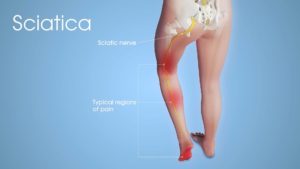SCIATICA- CAUSES, SYMPTOMS AND TREATMENT
It is not unknown to any of us that the world is moving at an increasingly fast pace with each passing day. We, as a part of it, are trying to keep up with its pace as much as we can.
But the price we have to pay for this can sometimes be huge. The biggest price is our health. We often see people compromising with their health and well-being just to achieve certain goals, and we do the same.
Although success is very important in recent times, at the same time we also need to acknowledge that nothing comes above one’s own physical and mental health.
Back problems are increasingly becoming prominent and new cases for the same are seen every day in big numbers. That in itself is proof enough that people are neglecting their bodies.
Another common problem alongside slipped disc, cervical pain, spondylosis, etc is Sciatica.
WHAT IS SCIATICA?

A nerve termed the sciatic nerve runs along the back of a human body, which branches near the lower back going through the hips, buttocks, and down each leg.
The sciatic nerve is the longest and thickest nerve in the body, which runs along the respective legs, ending into feet.
A mild or sharp pain that radiates through this nerve is called Sciatica. It is pain caused by a slipped disc or bone spurs or even muscle spasm.
It provides a sensation of irritation, pinching, compression or inflammation. It is mostly a pain that affects only one side of the body. It is felt in the lower backs, hips, buttocks, and one of the legs. However, it is possible for it to occur in both legs depending on the affected area of the nerve.
CAUSES OF SCIATICA
The most commonly known causes of sciatica are:
- SLIPPED DISC- The most common cause of sciatica is a condition called slipped disc. When the slipping or rupture of a spinal disc causes injury to the sciatic nerve or presses on this nerve, it causes pain and numbness.
- INJURY- Any injury to the spine or sciatic nerve can be a root cause of the pain caused by sciatica.
- TUMORS WITHIN THE SPINE- The presence of cancer or tumor in the lumbar spinal canal can press against the sciatic nerve causing pain.
- INFECTION- An infection near the sciatic nerve, though not common, can be a cause of sciatica.
- LUMBAR SPINAL STENOSIS- When the lumbar spinal canal narrows abnormally and unexpectedly, the available space for the spinal cord and nerves reduces. It increases the chances of something pressing against the sciatic nerve, thus causing sciatica.
- DEGENERATIVE DISK DISEASE- The natural wear and tear of the spinal disc can either cause a slipped disc, or spinal stenosis, both of which may lead to sciatica.
- OSTEOARTHRITIS- With age, bone spurs may form in the spine and press against the lower back. This may affect the sciatic nerve, thus causing pain.
- SPONDYLOLISTHESIS- It is a condition where one vertebra (bones of the spine) slips out of line with the one above it. This causes the narrowing of the opening through which the nerve exits. This extended bone may press against the spinal nerve, causing sciatica.
- CAUDA EQUINA SYNDROME- It is a rare condition that affects the bundle of nerves at the end of the spinal cord called cauda equina. It causes pain down the leg, numbness and the patient loses the sense of passing urine & stool.
- PIRIFORMIS SYNDROME- When a small muscle, called the piriformis muscle, that lies in the buttock, tightens or spasms, it causes piriformis syndrome. It is a neuromuscular disorder that can put pressure on the sciatic nerve, causing pain and numbness in the affected area.
RISK FACTORS for SCIATICA
The following factors can put you at risk of sciatica:
- AGING- Bones naturally wear and tear with age and it is easier to have weak bones or have a greater risk to nerves.
- OBESITY- Being overweight can cause unwanted extra pressure on the spine, affecting the bones and the nerves.
- WEAK CORE- Having a weak core means having less support for the lower back ie week muscles around the backbone, thus increasing the risk of sciatica.
- DIABETES- Having diabetes increases the possibility of nerve damage, thus making you more prone to sciatica.
- INACTIVE LIFESTYLE- No exercise, or movement reduces the flexibility and toning of the muscles, thus increasing the possibility of sciatica.
- SMOKING- Smoking, and intake of nicotine weakens the bones, damages spinal tissue, and increases the chances of slipped discs, thus increasing the risk of sciatica.
- IMPROPER POSTURE- Lifting heavy objects with an improper posture can put a large amount of strain on the back, increasing the risk of sciatica.
- HAVING A PHYSICALLY DEMANDING JOB- If your job demands high physical activity, the possibility of wear and tear of the spine and nerves increases, which can risk sciatica.
- PREGNANCY- During pregnancy, the added weight, hormonal changes, and the baby’s weight and position can affect the lower back, especially the sciatic nerve.
SYMPTOMS of SCIATICA
- PAIN- A constant burning sensation or shooting pain in the lower back, hips, buttocks, and down one of the legs, sometimes both.
- WEAKNESS- Weakness in the leg and foot and heaviness in the affected leg.
- NUMBNESS- Feeling of numbness in the affected leg and/or the back of the leg.
- PINS AND NEEDLES SENSATION- A feeling of pins and needles in the leg, toes, or foot of the affected leg.
- TINGLING- A tingling sensation down the knee and calf of the affected leg.
- PAIN THAT WORSENS WITH MOVEMENT- Any kind of movement like trying to get up, walking, climbing stairs, or simply bending may aggravate the pain.
- LOSS OF BOWEL AND BLADDER CONTROL- This is caused due to cauda equina syndrome. The patient loses the sense of passing urine & stool.
DIAGNOSIS of SCIATICA

- PHYSICAL EXAMINATION- It is done for testing muscle strength and reflexes. It may involve stretching and some exercises to determine the cause of pain.
- NERVE TESTS- This allows doctors to examine how the sciatic nerve is carrying the sensations and check for any abnormalities. This helps in knowing the degree to which, the sensation is being slowed or changed in the affected area.
- IMAGING TESTS- These include the following tests.
- – X-ray is used to reveal a bone spur.
- – MRI gives detailed images of bone and soft tissues such as a slipped disc and nerves.
- – CT Scan is used to image the spine by injecting a contrast dye into the spinal canal.
- – Electromyography (EMG) measures the electrical impulses of the nerves and muscle response. It can confirm nerve compression by a slipped disc or spinal stenosis.
TREATMENTS for SCIATICA
A lot of times, sciatica can be treated by self-care and taking care of one’s lifestyle. These include:
- ICE PACKS OR HOT PACKS- Start with ice packs to reduce pain and swelling. Do this for a few minutes, several times a day. After a few days, switch to using a hot pack for a few minutes at a time. If pain remains, use the one which relieves you the best.
- OVER THE COUNTER MEDICINES- NSAIDs may help reduce pain, swelling, and inflammation. As an alternative to NSAIDs, you can use acetaminophen.
- STRETCHES AND EXERCISES- Gentle and proper stretches learned from an experienced and skilled instructor may help with the pain. Aerobic exercises and core muscle strengthening exercises also prove to be helpful. Though exercises have more of a preventive role rather than treating the problem.

If none of these treatments work, it is better to seek professional help. A few treatments suggested by a doctor may include:
- MEDICATIONS- Medication prescribed by the doctor may include muscle relaxants, nerve pain medicines, etc. Pain medications are prescribed depending upon the level of pain.
- PHYSICAL THERAPY- Find exercises that help in reducing the pressure on the sciatic nerve, thus reducing sciatica. Walking, swimming, water aerobics, etc. are helpful exercises and must be included in the exercise program. The doctor may refer you to a physical therapist who can help strengthen the back muscles.
- SPINAL STEROID INJECTIONS- A temporary relief in the pain and swelling may be provided by injecting steroids (an anti-inflammatory medicine) into the lower back under local anesthesia.
- ALTERNATIVE TREATMENTS- Treatments like acupuncture, yoga, or spine manipulation by a licensed chiropractor can be used to treat and manage the pain. Massage may help with muscle spasms.
- SPINE INTERVENTIONS- All the methods mentioned above, must provide positive and satisfactory results within 15-20 days. However, if there is no relief from the pain in 3-4 weeks or if the pain returns after temporary relief, one must consult specialist doctors who focus on spinal problems. This is because you may need certain non-surgical, minimally-invasive, keyhole treatments. It is generally seen that in almost more than 90% of patients, one or the other spine intervention is usually required for sustainable pain relief or sciatica cure.
- SPINE SURGERY- In almost 1% of patients, surgery is always the last resort of a doctor to help with the condition of sciatica. It is only suggested if any medication or therapy or treatment proves to be useless and if the condition keeps worsening. The surgical options may include:
- Microdiscectomy
- Laminectomy
HOW TO PREVENT SCIATICA
Certain steps can help in reducing the risk of sciatica. These are:
- GOOD POSTURE-maintaining a good posture while sitting, standing, and picking up objects, whether heavy or light, always helps in reducing pressure on the lower back.
- QUIT SMOKING- Quitting smoking reduces or completely gets rid of the nicotine supply to the body, which reduces the chances of weakening of muscles and bones.
- MAINTAINING HEALTHY LIFESTYLE- Try to take a properly balanced diet and maintain weight to remove the extra pressure from the spine. It helps you in leading a healthier lifestyle.
- REGULAR EXERCISE- Regular light exercises keep the body active, flexible, and make the core strong. It helps in supporting the spine better.
- TRY NOT TO HURT THE BACK- Try not to engage in activities that can cause harm to the back and try to avoid any injuries to your back.
CONCLUSION
Sciatica is increasingly becoming a common condition. The presence of sciatica-like pain is a symptom of urgent concern. Taking early help from a specialist doctor can save you from an unnecessarily long and difficult treatment. To prevent yourself to be a victim of it, maintain your lifestyle. In case of any symptoms, seek help immediately.
Visit the Best Doctor for Sciatica or for any other Spine Problems in Delhi, Dr. G N Goyal, at the nearest Spine and Pain Clinic, and book your appointment now!
CONTACT US
You may please click on the following link, to know the pleasant experiences of our patients.
https://www.youtube.com/channel/UCcxcwB9EluBKZoG0Q2z7ATg/videos
REFERENCES


Mujhe bhi sciatica ki problem h left pair par lod nahi jyada chal nahi pata
S.k.mansuri September 1, 2021 at 10:44 am
Mujhe bhi sciatica ki problem h left pair par lod nahi jyada chal nahi pata